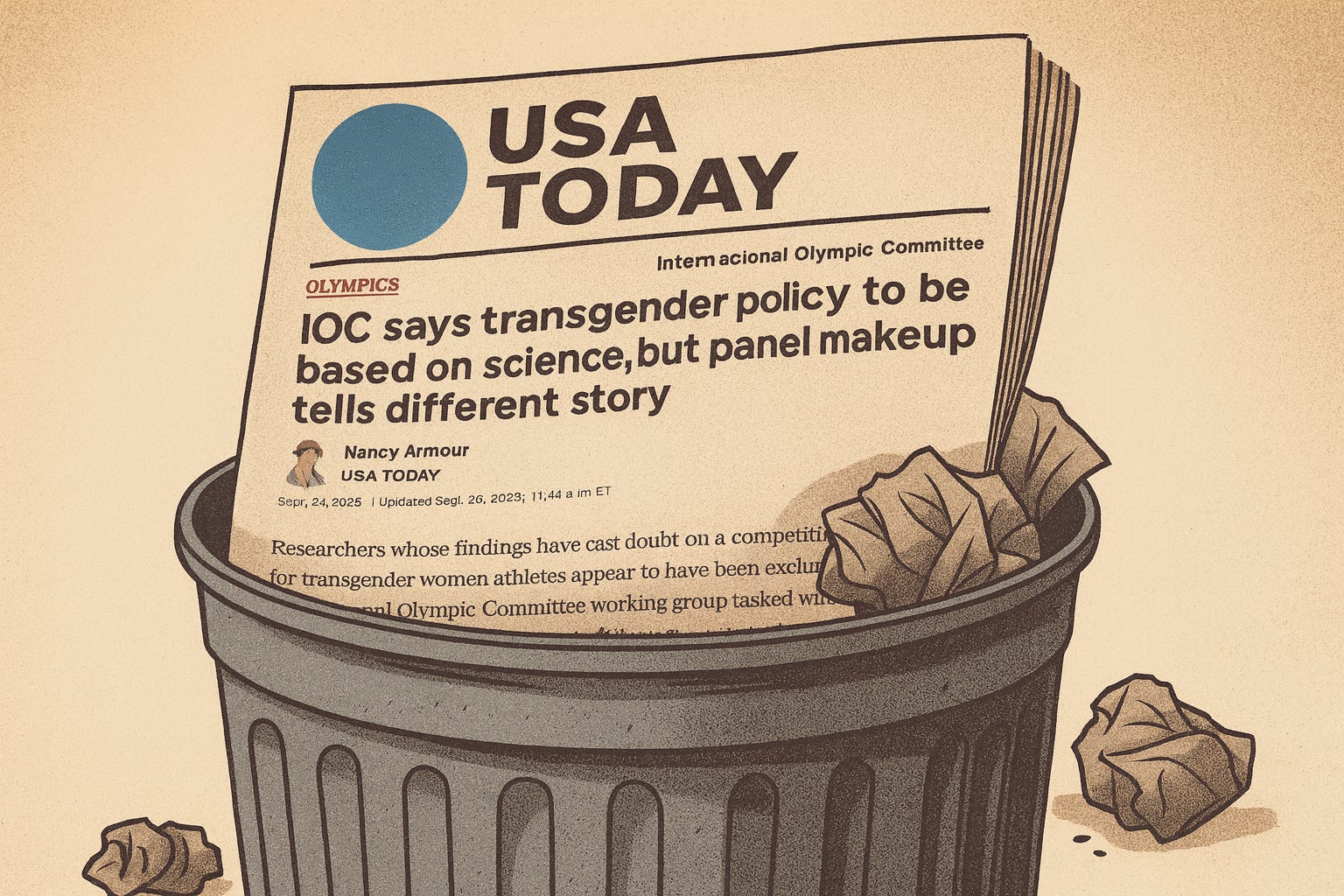Nancy Armour Ignores The Simple Truth That ‘Transwomen’ Are Male
Armour misleads USA Today readers by ignoring published critiques that exposed serious flaws in the IOC’s favored research.
Reality’s Last Stand is a reader-supported publication. Please consider becoming a paying subscriber or making a one-time or recurring donation to show your support.
About the Author
Dr. Greg Brown is a professor of Exercise Science at the University of Nebraska at Kearney. He is a member and fellow of the American College of Sports Medicine (ACSM), the National Strength and Conditioning Association (NSCA), the National Association of Scholars (NAS), and the Association of American Educators (AAE).
In a recent USA Today column, Nancy Armour dismisses the International Olympic Committee’s scientific panel on transgender participation in the female category as illegitimate because it excluded certain researchers. Her argument hinges entirely on the claim that the authors of a deeply flawed 2024 IOC-funded study—one that conveniently reported transwomen performed the same as, or worse than, females on some measures—were unfairly left out. What Armour does not tell readers is that this very study has been widely criticized for poor design and analysis. Two rapid responses in the British Journal of Sports Medicine and a detailed critique in Reality’s Last Stand have already exposed its serious methodological and analytical failures. By ignoring this body of criticism, Armour misleads her audience and recycles bad science to advance a narrative rather than grappling honestly with the evidence.
The flaws in the 2024 IOC-funded study are worth underscoring. It compared 23 unfit males undergoing testosterone suppression as part of so-called “gender-affirming hormone therapy” (i.e., transwomen) to 21 very physically fit females. Despite the males being, on average, eight inches taller, 51 pounds heavier, carrying 27 pounds more lean body mass, and demonstrating 18 percent greater handgrip strength, 14 percent higher maximal aerobic capacity (VO₂max), and 15 percent more vertical jump power, the authors nevertheless claimed transwomen performed the same as—or even worse than—the females in some fitness measures.
They reached this conclusion only by engaging in statistical sleight of hand, “adjusting” performance outcomes for body mass or body size in ways that obscured the obvious male advantage. Worse, they asserted that because participants merely had to “participate in a sport at a competitive level or undergo physical training three times per week,” the study represented a comparison of equally trained and equally talented athletes. This is nonsense, and scholars across disciplines have said so. Readers seeking a fuller accounting of the study’s failures should consult the published critiques, which make clear that Armour’s reliance on this research is not journalism in service of truth but advocacy dressed up as reporting.
Armour further claims that “most of the studies used to ban transgender women so far are based on the performances of cisgender men, which scientists have argued is not an appropriate comparison.” This talking point has been recycled for years by transgender activists and their allies, including Johanna Harper and colleagues, the Canadian Centre for Ethics in Sport, and Joshua Safer, Executive Director of the Mount Sinai Center for Transgender Medicine and Surgery. The suggestion is that comparing transwomen to males is methodologically flawed. But this is rhetorical sleight of hand designed to obscure biological reality. Humans are male or female, and transwomen, by definition, are male. To argue otherwise is to deny the very basis of sex and the reason male bodies consistently outperform female bodies in athletics.
Rather than parroting activist talking points, it is worth returning to the evidence. If transwomen are male—as biology makes clear—then they should be compared to other males in scientific research and should compete against males in sport.
One particularly useful study comes from Miranda Scharff and colleagues, who examined 249 transwomen and 278 transmen (i.e., females who identify as men) before and after one year of testosterone suppression. The baseline data speak for themselves: transwomen had grip strength 26 percent higher than females. That level of strength placed them only in the 20th percentile among males—meaning weaker than 80 percent of men—but in the 90th percentile among females, stronger than 90 percent of women. Their baseline testosterone concentrations ranged from 12.2 to 23.0 nmol/L, entirely within the normal male range of 10–35 nmol/L. By contrast, the female range is 0.5–2.4 nmol/L, with no overlap whatsoever. Their estradiol (estrogen) levels also fell squarely in the male range and were lower than those of the baseline females in the study. In short, this dataset provides no biological evidence that transwomen are anything other than male.
Another important study, by Anna Wiik and colleagues, carefully tracked 11 transwomen and 11 transmen before and after 12 months of hormone intervention. Once again, the baseline data made the biological reality unmistakable: transwomen presented with male-typical values for hemoglobin, testosterone, and estradiol, as well as normal male levels of muscle volume and strength. Just as telling, the transwomen were on average 12 centimeters (4.7 inches) taller than the females—almost exactly the well-established sex difference in height across the general population. These traits are not cosmetic; they are the very physiological factors that underpin superior male performance in endurance, power, and strength-based sports.
Additional research confirms these findings. Studies by Defreyne et al., Wierckx et al., and Auer et al. all show that transwomen, prior to beginning hormone treatment, exhibit male-typical values across a wide range of biological measures, including height, lean body mass, handgrip strength, hemoglobin, testosterone, and estradiol. Taken together, these studies reinforce the inescapable conclusion: transwomen are biologically male, and their athletic profiles reflect that reality.
The same body of research—by Scharff, Wiik, Defreyne, Wierckx, and Auer—also makes clear that male–female differences in height, muscle mass, and muscle strength are not erased by “gender-affirming” hormone treatment. Height, of course, remains unchanged. And while testosterone suppression and cross-sex hormones may slightly narrow the sex-based gaps in muscle mass and strength, the fundamental male advantage remains.
Sports governing bodies such as World Athletics, World Boxing, the International Ski and Snowboard Federation, and others have already acknowledged these facts, implementing eligibility rules that restrict female categories to those who are biologically female. These policies reflect the scientific consensus that male athletic advantage is real, enduring, and incompatible with fair competition in women’s sport. The IOC should recognize this as well.
This is not intended to be an exhaustive catalogue of every study on this topic, but the conclusion is unavoidable: the scientific literature consistently shows that transwomen are male by every known biological standard. There is no biological test for a person’s “transgender identity,” because identity is not biology. Sex, by contrast, is an essential, binary biological characteristic in mammals, including humans. Sex is encoded in every cell of the body, and it cannot be changed by surgery or hormonal intervention. Given this, it is difficult to see how anyone claiming expertise in biology could credibly assert that transwomen are anything other than male.
Ultimately, the debate is not complicated. The science is clear: transwomen are male, and male bodies confer enduring advantages in size, strength, and endurance that no amount of hormone suppression or surgery can erase. This is why sport has always been divided by sex, and why women’s categories exist: to give female athletes a fair chance to compete and to win. The female category is designed for females, not as a fallback option for mediocre males. The fact that some transwomen may be shorter, less muscular, or simply not elite male athletes does not make them female, nor does it justify placing them in competition against women. By relying on flawed studies and activist talking points, Nancy Armour and others obscure this reality and mislead the public. The International Olympic Committee has a responsibility to ground its policies in biological fact, not ideology. Anything less undermines both the integrity of women’s sport and the credibility of science itself. Women’s sport deserves truth, not ideology.
If you enjoyed this free article, please consider upgrading to a paid subscription or making a recurring or one-time donation below to show your support. Reality’s Last Stand is a reader-supported publication, and your help is greatly appreciated.











The proposition that men can compete fairly against women is so absurd it's not even wrong. While I admire and salute Gregory Brown for going to the trouble to debunk Nancy Armour, really, who could possibly believe her? To have men competing in women's events has never been anything other than an abuse of power: "We are doing this because we can, and you don't have the power to stop us." Well, now we do, and this reprehensible misogynist practice will fade away. Maybe we owe a debt to Imane Khelif, who isn't even trans. We certainly owe a debt to those poor women who went into the ring with him.
I am a statistician. In many studies, PIs call for "adjusted means" which statistically modify the outcome means for various things. These are usually done legitimately, but should be avoided anyway. For long-term understanding, unadjusted simple means are the best, because later studies may not have the values or variables to adjust in the same way.
Statistical slight-of-hand is so common in the trannie world. The study of Tordoff et al (2023) used a completely illegitimate approach to make obviously similar outcomes look different. They fiddled with the data extensively, but it was obvious to anyone NOT in the trannie glamour zone that this was a huge lie.